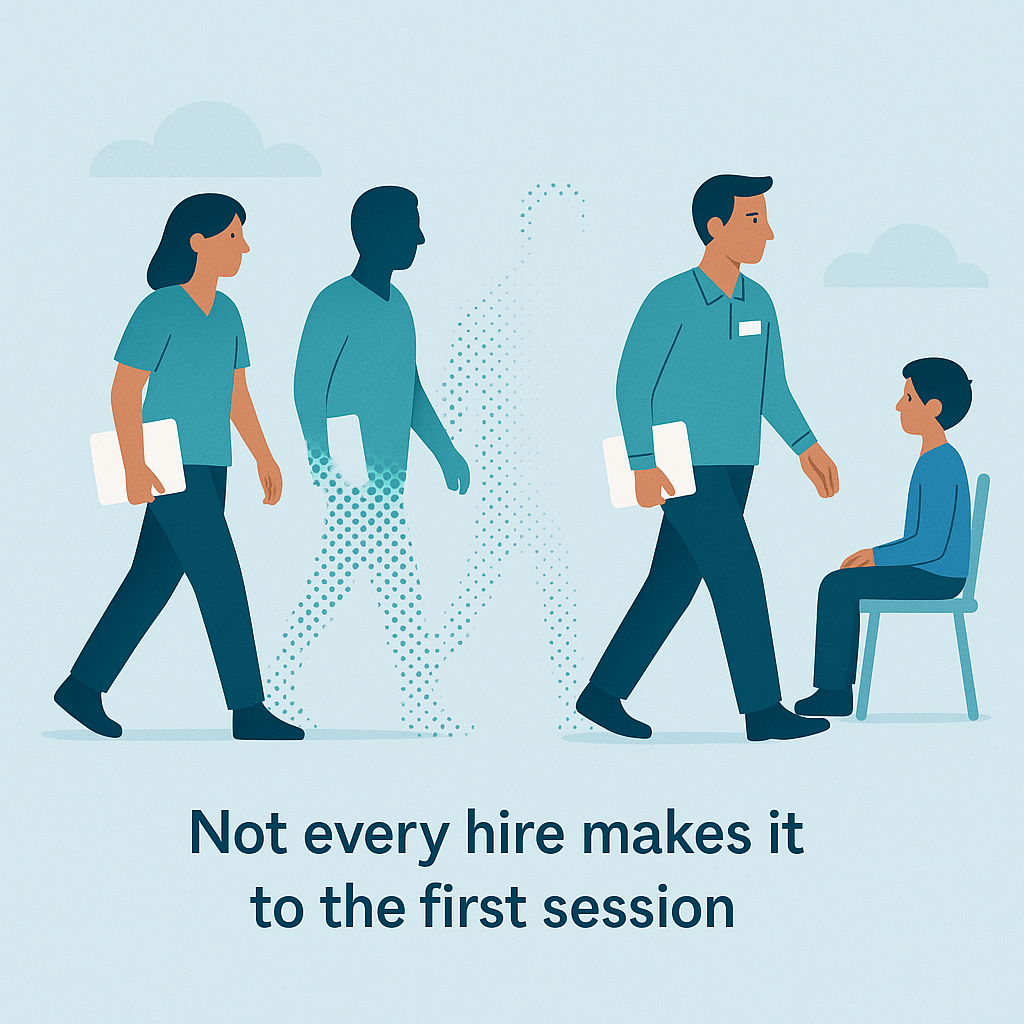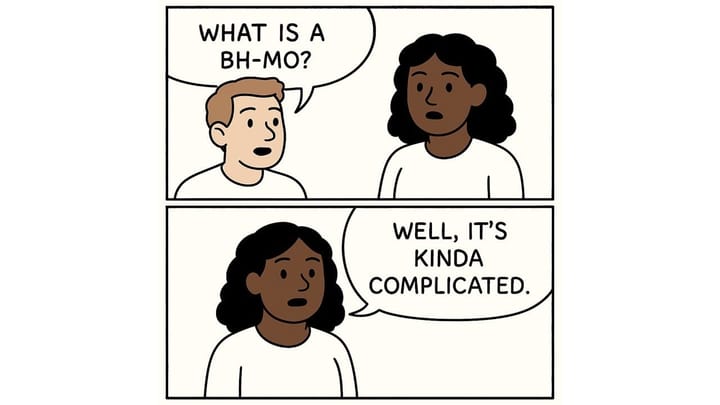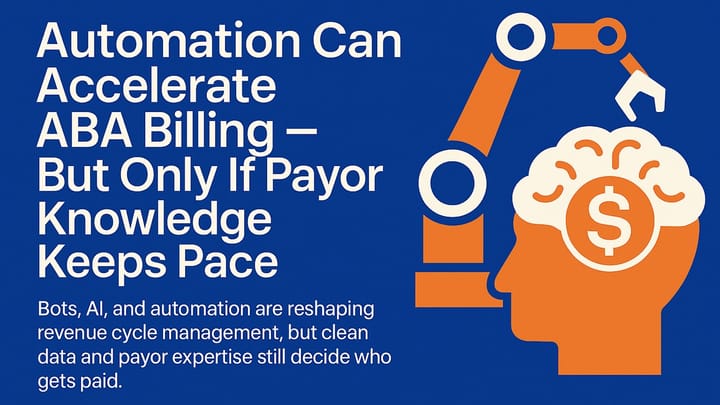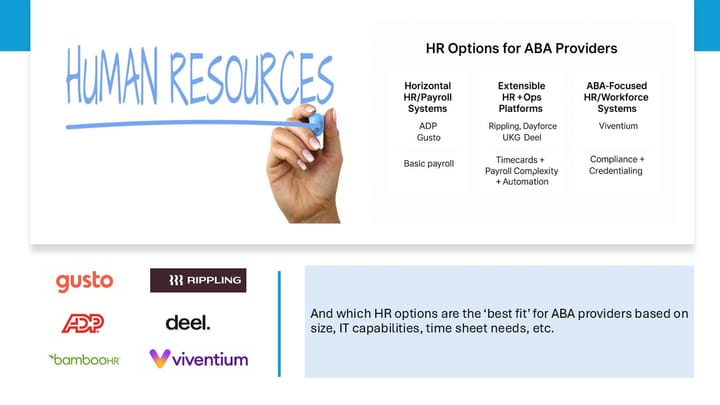From Offer to Impact: the often 'Vanishing' Therapist

How ABA Platforms Can Bridge the Hiring Gap That No One Owns
Hiring a new BT or therapist is a relief.
Getting them to their first therapy session is a gamble.
In the space between “offer accepted” and “first session delivered,” countless ABA providers lose their new hires—not due to pay, not due to poor interviews, but due to process failure, platform gaps, and unmet emotional needs.
It’s the most invisible attrition in ABA.
And it’s a problem no single system seems designed to solve.
The Gap Platforms Don’t Address
Let’s break it down:
- Applicant Tracking System (ATS) platforms usually hand off at "offer accepted"
- HRIS/HCM systems may handle onboarding docs—but don’t generally track readiness to start sessions
- Practice Management platforms only kick in once the person is staffed to a client
No single system tracks or supports the full onboarding-to-first-session journey.
It’s nobody’s responsibility—and everybody’s problem.
What Could Platforms Actually Do?
If you're building or configuring these systems, here's what best practice could look like:
🧭 1. Track Pre-Service Milestones
Your ATS, HRIS or Automation software could treat “Offer Accepted” as the beginning of a structured milestone journey:
- Background check complete?
- Training module started?
- Payor credentialing submitted?
- Assigned to a scheduler?
- First session confirmed?
Providers should be able to build checklists per role and state. This isn't hard—but very few systems support it.
🤝 2. Enable Pre-Service Cohorts
The lonely nature of this transition amplifies dropoff risk. Platforms could allow:
- Batch onboarding events (weekly Zooms, LMS modules, etc.)
- Shared cohort dashboards showing progress across peers
- Mentor assignment fields with prompts for outreach and check-ins
The emotional continuity here matters. A single text from a future peer—“Hey, we start training Monday, you good?”—can reduce falloff dramatically.
📲 3. Automate the Right Nudges
Most systems automate reminders like “Finish your W-4.”
But they rarely send reminders like:
- “Here’s what your first session might look like.”
- “Meet your supervisor—schedule a quick hello.”
- “You’re 3 steps from seeing your first client. Let’s get there.”
These aren't compliance messages. They’re engagement nudges. And they should live inside whatever tool the staff is already using.
⚖️ 4. Clarify Employment Status
This gets murky—fast.
Many providers assume that new hires aren’t employees until training is complete. But in most states, if someone:
- Signs an offer letter,
- Completes a training module,
- Receives payment for onboarding...
…they’re an employee under wage and hour laws. You’re responsible for minimum wage, time tracking, and classification even if they haven’t delivered a session yet.
What platforms need to do:
- Let HR/Legal define and apply status tags (“candidate,” “employee – pre-service,” “active provider”)
- Flag workflows with compliance implications (e.g., meal breaks required once training starts)
- Centralize audit trails across systems
This is an area ripe for error—and exposure.
Empathy Is Not an Add-On. It’s your Culture....and Risk Management.
The individuals in this transition phase aren’t just new hires. They’re future caregivers.
They’re about to walk into homes, meet families, manage behavior, and uphold your brand.
The dropout rate at this stage is a mirror.
It shows where you may have automated logistics but ignored the emotional experience.
Use platforms to:
- Schedule pre-first-session check-ins
- Send welcome messages from peers or families
- Offer optional “ride-along” shadow sessions
- Create quick video walkthroughs: what to wear, where to park, how the first 10 minutes go
These things build confidence, not just compliance.
This Is Fixable—But Not by One Tool Alone
There’s no perfect plug-and-play solution.
But there’s a clear playbook providers can follow—if platforms support them:
- Map the Transition Phase → what steps actually happen between offer and session?
- Assign Ownership → HR? Ops? Clinical? Who owns progress through the pipeline?
- Use Tags + Checklists → in ATS, HRIS, and PM, distinguish pre-service employees from active staff
- Automate Empathy → SMS, email, Slack, whatever channel works—reach out before they drop out
- Cohort and Mentor → normalize this stage as a team experience, not a solo journey
Providers Deserve Better Tools. Staff Deserve a Warmer Welcome.
This isn’t just a platform and process gap. It’s a reflection of how fragmented the journey is from candidate to clinician.
But it doesn’t have to stay that way.
Start by asking:
What happens after we send the offer letter—and before the first session is delivered?
And who, exactly, is making sure they make it through?



